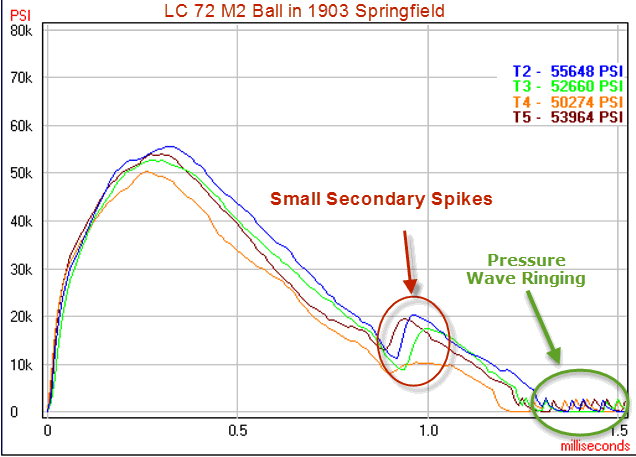Rimfire5,
Thanks for the follow-up. I wondered what your working approach was.
For others interested in this stuff, Dr. Lloyd Brownell found in his studies in the 60's that when a bullet jumps to the throat of a barrel and engraves into the rifling, the fore and aft chamber stretch caused by that event produces a pressure wave in the barrel that goes down the tube from the throat. It explained the small ripples superimposed on the pressure trace itself.
Below is an example from a .30-06 pressure measurement I made. In the green oval you can see the reflected waves most clearly when the pressure has dropped to zero. The ripples in the higher pressure parts of the waveform are also the effect of the pressure wave. If you look back at the starts of the traces, the ripples don't clearly appear until about 30,000 psi, or just under 0.1 ms, which is in the range of pressure and time at which you expect the bullet has jumped to the throat of the rifle and begun engraving into the rifling, initiating the wave. If you follow the colors carefully, you'll see they tend to travel in pairs (see the dark blue trace and green trace) or in triplets due to reflections off the back end of the receiver adding themselves in, but you do get dead spots. Because the waves can distort a muzzle a few tenths of a thousandth of an inch, especially when the muzzle has a thin wall profile, best accuracy occurs when the muzzle is undisturbed by the waves (when the dead spot is at the muzzle rather than at the breech end of the barrel).

Thanks for the follow-up. I wondered what your working approach was.
For others interested in this stuff, Dr. Lloyd Brownell found in his studies in the 60's that when a bullet jumps to the throat of a barrel and engraves into the rifling, the fore and aft chamber stretch caused by that event produces a pressure wave in the barrel that goes down the tube from the throat. It explained the small ripples superimposed on the pressure trace itself.
Below is an example from a .30-06 pressure measurement I made. In the green oval you can see the reflected waves most clearly when the pressure has dropped to zero. The ripples in the higher pressure parts of the waveform are also the effect of the pressure wave. If you look back at the starts of the traces, the ripples don't clearly appear until about 30,000 psi, or just under 0.1 ms, which is in the range of pressure and time at which you expect the bullet has jumped to the throat of the rifle and begun engraving into the rifling, initiating the wave. If you follow the colors carefully, you'll see they tend to travel in pairs (see the dark blue trace and green trace) or in triplets due to reflections off the back end of the receiver adding themselves in, but you do get dead spots. Because the waves can distort a muzzle a few tenths of a thousandth of an inch, especially when the muzzle has a thin wall profile, best accuracy occurs when the muzzle is undisturbed by the waves (when the dead spot is at the muzzle rather than at the breech end of the barrel).

